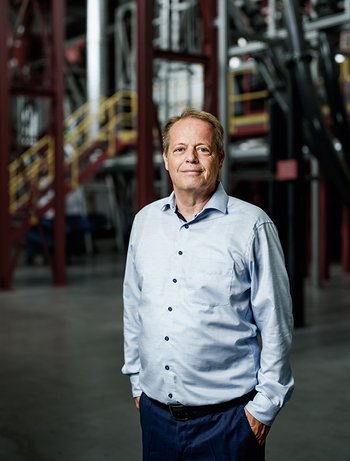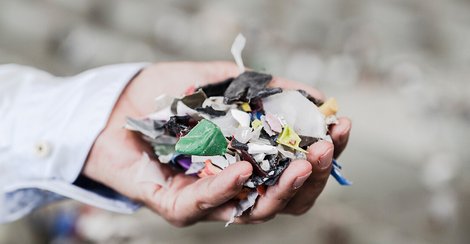Recycling must be worthwhile!
It's a topsy-turvy world: a material that outlasts human life is quickly used as packaging film and then ends up in growing mountains of rubbish or in the sea. We need to change that, says Dr Dirk Textor ...
Dr Dirk Textor, Chairman of the Plastics Recycling Association at the German Association for Secondary Raw Materials and Waste Management (Bundesverband Sekundärrohstoffe und Entsorgung e. V.), is quite angry about how wrongly plastic is used around the world. But where do we start to change this? Could CO2, of all things, be a lever for this? He revealed this to us in an interview ...
Dr Textor, there are huge amounts of plastic floating in our oceans. Many beaches are full of rubbish. Fish and birds are starving to death with plastic-filled stomachs - how sustainable is plastic really?
Plastic is a very sustainable material, but it all depends on how we use it. One of its fantastic properties is durability. However, this can become a problem if it is disposed of improperly and ends up in the sea. Longevity is actually a very positive property, but the plastic manufacturing industry has managed to ensure that we use plastic for very short-lived products. To a certain extent, this also has to do with their growth model. Because what breaks quickly has to be replaced quickly ...
We've already talked about the worst-case scenario for plastic disposal, but what happens to a plastic product after its first life in the best-case scenario?
In the best-case scenario, the first life of the plastic product doesn't end so quickly; instead, we use the plastic for a long-lasting product. Because one thing is clear: avoidance always comes before recycling. At some point, however, most products will have reached the end of their useful life and then, ideally, they will be recycled and reused. You at GRAF are even turning the wasteful logic of the plastics industry into something positive: very short-lived products, namely packaging, are turned into very long-lasting environmental products through recycling, which in themselves form cycles and can be recycled again at the end.
So much for the positive and negative scenarios. As the end consumer, do I have any control over how this turns out?
Here in Western Europe, in Germany, we have our waste separation systems. I can make a difference in everyday life by deciding which bin I put my waste in. But if we are honest, we as a society must learn above all to simply consume less of these short-lived products. Avoidance comes first! During the pandemic - as terrible as it has been - we have managed to do this, for example by reducing the amount of certain plastics in the world's mountains of rubbish by 10 to 15 per cent. But how can we do the same in normal times?
EU Commission President Von der Leyen has announced the end of the throwaway society in 2022. You would think that would mean everything is in order. In reality, however, consumption is continuing to grow worldwide.
In fact, consumption is increasing dramatically worldwide - and in Europe it is also increasing, albeit not at the same rate. The end of the throwaway society is therefore unfortunately an illusion - whether you set 2030 or 2035 as the deadline. In this respect, we need ways to work with the plastic that we consume.
What then needs to be done politically?
New plastic must become more expensive. There is a global market for virgin material and if we look at the price trend over the last twelve months in particular, it is clear that plastic will become cheaper and cheaper in the long term and that recycling, on the other hand, will have an increasingly difficult time. That's why I say: we need an incentive for recyclers and users of recyclates so that their use is also financially worthwhile. In my view, CO2 would be a suitable lever here, because you can generally calculate that we save two kilograms of CO2 for every kilogramme of recycled material that replaces virgin material. If we were to add the CO2 rucksack to the price of the new product, it would of course be more expensive. Or you would have to make it so that those who use recycled plastic receive a financial reward per kilogramme of CO2. Whether it's plastic, metal or paper - recycled materials always become established as mass-produced goods when they are cheaper than virgin material.

What are the chances of this regulation coming?
I'm pretty sure that it will come. The question is rather in what timeframe and whether all medium-sized companies will survive until then. This is because the recycling industry, in contrast to the plastics-producing sector, is characterised by SMEs. There is a threat of a market shakeout by the chemical industry, which can indeed utilise plastics chemically, but not materially. However, the CO2 footprint is larger. GRAF has the advantage in the SME sector that you as a company produce your own recyclates. The fact that you invested early out of conviction and can now draw on 40 years of experience is paying off here.
But does the circular economy as a whole now have poor prospects?
No, I see a rethink. And that is sorely needed. After all, the world's prosperity is growing and with it the consumption of resources. This makes it all the more important that we consider the recycling of a product right from the design stage. The idea of the circular economy will change our everyday lives. As a society, we can only welcome this revolution and transformation - and place it in our gardens in the form of a rainwater tank, for example.




